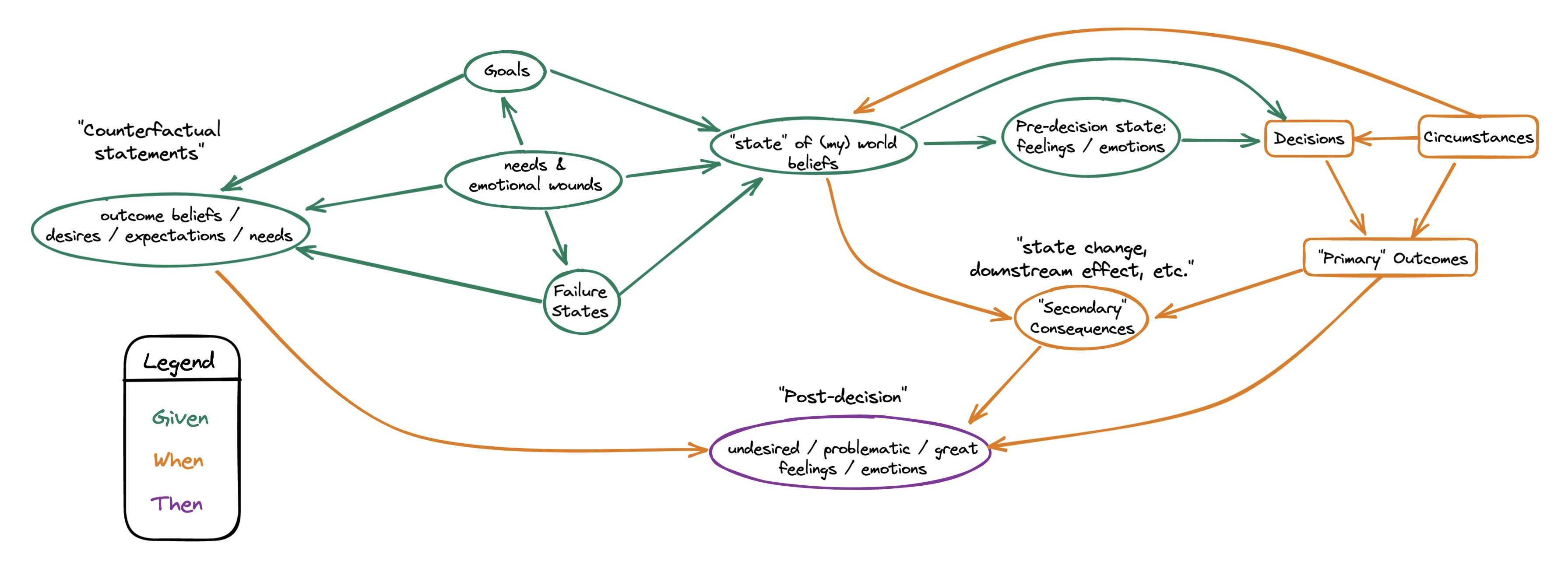Questions for Introspection: Part 2
More questions to help develop a personal problem understanding.
Questions for Introspection: Part 2
Dear Young Tim,
Happy end of the first quarter of 2022!
Being a time of endings and new beginnings, this seems a good time to close the loop on our posts from September and October, 2021. To bring us all back up to speed, the scene is as follows.
We’re often trying to self-improve.
The process
for this improvement involves introspecting,
to make clear and then make right
our beliefs, wants, needs, feelings, and behavioral patterns.
The graph below depicts how the various elements of
our introspection relate to each other.
Beyond illustrations,
it is helpful, especially in emotionally charged moments,
to have a list of questions to ask
about each introspection element.

Our post from October 2021 provided such a list for the “when” and “then” nodes in the graph above. Today’s post provides a list for our remaining introspection graph elements, the “given” nodes. These elements cover the parts of our story that give context for our behavioral decisions and feelings.
As before, these questions are stated without introduction, since the elements of our introspection graph were described previously, in September 2021’s post. These questions are meant to guide our “meditating” or thinking deeply about our role in our problems.
Needs and emotional wounds
- “Referring to the lists1 of emotional wounds we carry, which wounds are triggered by our current situation?”
- “Which past experiences/wounds are affecting which parts of me (behaviorally)?”
- “Referring to our lists of needs, what needs does each of our activated parts have in this situation?”
- “Beyond the pre-identified needs, is there anything else we need in this situation? Try to think of things which would bring satisfaction, beyond just resolving the current situation.”
- “How can we give the parts of us with emotional wounds, some of what they need right now?””
Goals
- “How do I wish to respond to problems, in general?”
- “What do I most want or desire right now?”
- “What do each of our activated parts want?”
- “Based on our needs and beliefs, what were our goals or desires, coming into this situation?”
- “What are my goals? (what/why/how)”
- “How can I reframe my goals / failure-states / problems in such a way as to alleviate the undesired outcomes or consequences (including undesired feelings or emotions)?”
- “If our goals are reachable given some series of our own actions, how can we substantively and immediately progress towards them?”
Failure states
- “Based on my emotional wounds and needs, what ‘reasonably likely’ outcomes do I most wish to avoid?”
- “What am I most afraid of right now?”
- “What are my definitions of failure?”
- “How can I reframe goals / failure-states / problems in such a way as to alleviate the undesired outcomes or consequences (including undesired feelings or emotions)?”
- “If our failure steps are avoidable given some series of our own actions, how can we substantively and immediately guard against or prevent failure?”
State beliefs
- “Given our goals, failure states, needs, and emotional wounds, what did we believe about our state coming into this situation?”
- “Given our goals, failure states, needs, and emotional wounds, what did we believe about our external circumstances in this situation?”
- “What do each of the activated parts believe about our overall state?”
- “What fear about the situation did each part of you start with?”
- Disputation questions from cognitive behavioral therapy (per belief):
- “What is the evidence for this belief?”
- “What are alternative-viewpoints / statements of this belief?”
- “What is the usefulness of this belief?”
- “What common thinking errors and biases might this belief be partially formed by?”
- “What can I do to take action based on this belief (or its restatement/refutation) right now?”
Outcome beliefs
- “Given our goals, failure states, needs, and emotional wounds, what prior beliefs did we hold about potential outcomes of our situation? E.g. outcome X is unlikely, or outcome Y should not occur because Z.”
- “Given our goals, failure states, needs, and emotional wounds, what prior beliefs did we hold about potential outcome consequences? E.g. if outcome X occurs, then it means Y or Z will happen.”
- “What did each of the activated parts believe about our potential outcomes?”
- “What fear about the potential outcomes did each part of you start with?”
- Disputation questions from cognitive behavioral therapy (per belief):
- “What is the evidence for this belief?”
- “What are alternative-viewpoints / statements of this belief?”
- “What is the usefulness of this belief?”
- “What common thinking errors and biases might this belief be partially formed by?”
- “What can I do to take action based on this belief (or its restatement/refutation) right now?”
Pre-decision feelings
- “What do I feel, even now, when thinking of my state beliefs above?”
- “What parts of us are or were activated when thinking of our state beliefs? Where in the body is or was this activation felt?”
- “Which, if any, parts of us are in conflict before our decision, and why?”
- “How could we have, or how might we in future similar situations, give the parts of us with emotional wounds some of what they need before decision-making?”
- “What feelings do we wish we channeled before our decision?”
- “In the future, how can I activate the parts of me with the emotional and behavioral traits I wish to display/use in this situation?”
- “In this situation, how could I switch emotional states altogether, from undesired state to desired state, e.g. fear -> excitement or anger?”
-
Such lists might be generated from the Self-Therapy Journey quizzes or curated from their overall list and similar ones. ↩